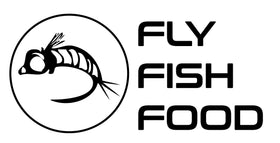Project Hopper
Cheech - June, 2015

The Project Hopper is just that - a project. This fly has been in the process of being made for about 2 years now (as of 2015) and will probably still be tweaked and modded based on fishing situations.
When you leave your car in anticipation of hitting the water in mid to late summer it's always a good thing to see hoppers flying around on the trail to the river or lake. You are sure that the fish will be shamelessly slamming these big morsels of steak floating awkwardly downstream. One summer I got schooled by a lack of selection in my hopper game, and the problem was that I thought I had my hoppers all figured out. I didn't. Up to this point the Stoneflopper was about all I needed when a hopper situation came up, and this day was going to be a good Stoneflopper day. The problem was that the fish would come over to the fly only to give it a good stare down and a window shop before returning to their feeding lanes. The Stoneflopper was getting the shaft... Hard. Time to start a project.
These types of situations really motivate me to come up with a better solution, and I realized that my hopper game had a lot of innings yet to be played. I immediately began trying to catch hoppers to analyze their colors and how they sat in the water. Luckily Curtis has a little fairy net that he uses to catch adult mayflies and such... I began to realize that even similar looking hoppers could have different colored back legs, and I found green, blue, red, and variations of all of these colors. As I began my testing I knew that the back leg would play a key part in the process so I made a mental
note to not skimp on them. I have seen some great hoppers with knotted rubber legs, but it takes a special type of black magic to get the knots to sit at the perfect tension to create a 90 degree angle out of the rubber. After a few poor attempts with rubber legs I decided to get really creative with the leg, and I didn't just want to slap on those pre-molded hopper legs... Foam and monofilament made some great legs, but in recent testing I'm confident that the mono legs impeded some hookups, so I changed them to centipede legs. The body is pretty basic, and I was basically just cutting a big hunk of foam down to the shape that I wanted. River Road cutters took about 15 minutes out of the process of tying this fly. Once the legs and body were made, it is about as simple as a fly gets.
After the first prototypes came off the vise I wanted to test them on the same fish that were snubbing the Stoneflopper, so back to the river we went. Luckily, we found the same exact fish holding in his territory and he was actively scanning for food. I made a cast that caught some wind and got pushed 6 feet out of it's feeding lane, but this fish rushed over without hesitation and tried to swallow my hopper whole. We knew we had a winner. That fly was actually much more durable than we thought it would be, and the monofilament leg sections stayed put for about 5 fish before they both got ripped off. That being said, the pattern still produced after the legs were gone.
Test number two came at a lake that was loaded with picky tiger trout. These fish were notorious for rushing over to your fly and rubbing their nose on the bend of your hook before turning away. They were hopper eaters, and they were EXTREMELY picky. I started out with the Stoneflopper and the window shopping commenced. I then tied on the Project Hopper and made a point to present it to the same fish that snubbed the Stoneflopper. They ate it. They ate it a LOT.
Durability... The first thing that people ask is how this fly holds up to being fished a lot. My answer at first was that this pattern was such a pain in the butt to tie that they should only have a few of them in their box as a last resort, but now that the process is simplified and improved a bit, there is no reason not to have a box full of them. With the improvements made to the back leg, they should last much longer than expected. Sure, there are flies out there that are much more durable, but this one is surprisingly more durable than you would think.
Modifications... Feel free to mod this fly as you see fit! As you can see in the images, there are many mods that you can make from a different hook, to a different shape for the body...
~Cheech
- Hook: Fulling Mill 35105 Competition Heavyweight Hook Barbless - 8
- Thread: UTC Ultrathread 70 Denier - Wood Duck
- Body: Rainy's Cross-Link Sheet Foam - Tan - 6 mm
- Leg: MFC Foto Foam - Tan
- Leg: Speckled Centipede Legs - Speckled Clear Tan - Medium
- Pronotum: Rainy's Cross-Link Sheet Foam - Tan - 1 mm
- Wing: EP Trigger Point Int'l Fibers - Pale Morning Dun
- Cutter: Project Hopper Foam Body Cutter Set - #10
- Adhesive: Fly Tyer's Z-Ment
- Tools Used: Renzetti Traveler Vise 2000 (Pedestal), C&F Design Bobbin, Dr. Slick Tungsten Carbide All Purpose Scissors, 4",




